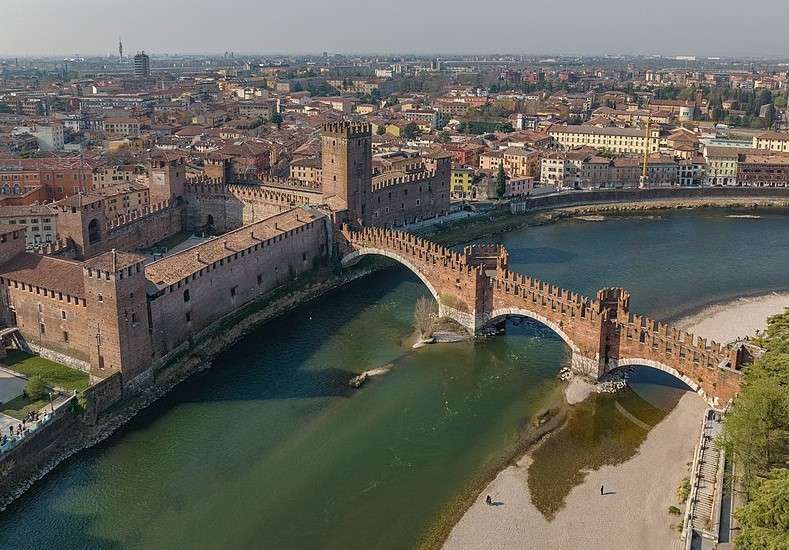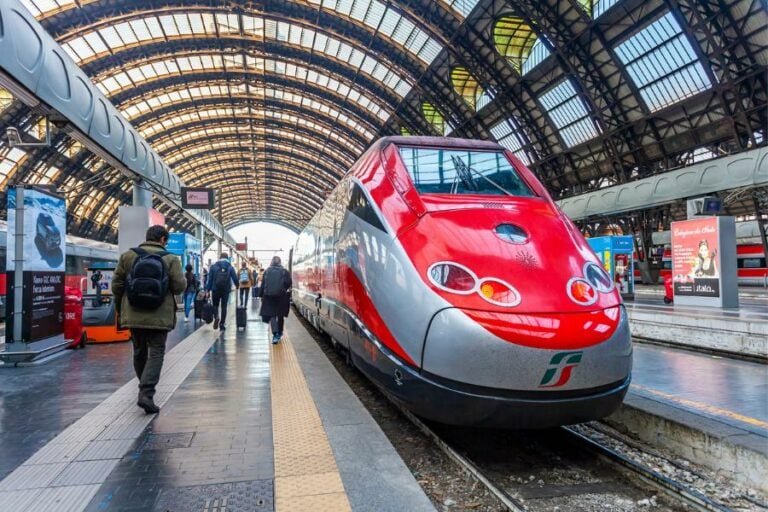Spend One Day in Verona, Italy: A Perfect Itinerary

Ciao a tutti, travel lovers! I’m your host on this One Day in Verona tour. Let’s discover the top things to do and see in Verona, ensuring your one day in this enchanting city is filled with beauty and wonder.
Short on Time? Here’s Your Verona One Day Itinerary
I recommend reading through this entire article to make informed decisions. However, if you’re short on time, here’s a concise Verona itinerary to help you maximize your day.
Morning:
- Start your day at the Arena di Verona and Piazza Bra.
- Visit Piazza delle Erbe, Torre dei Lamberti, and Piazza dei Signori.
Afternoon:
- Enjoy a late lunch at a local eatery.
- Visit Juliet’s House.
- Visit the Castelvecchio Bridge and Museum.
Late Afternoon / Evening:
- Walk along Ponte Pietra before dinner with a view of the Adige River.
Keep reading for details on each of the recommended landmarks and discover the best things to do to create your perfect one day in Verona.
Best Things to Do in Verona in One Day
Embarking on a one-day journey through the city of Verona, you’ll uncover the city’s vibrant culture and rich history, nestled within its compact, walkable historic center.
Let’s delve into the landmarks that make up our Verona in one day itinerary.
Arena di Verona

Imagine stepping into the Arena di Verona, where the stones echo the grandeur of ancient Rome. This colossal amphitheater, built in the 1st century AD, stands as one of the best-preserved ancient structures of its kind.
As you enter, you’re walking on the same ground where gladiators once battled, drawing tens of thousands of spectators. Today, it’s a world-renowned venue for opera, hosting spectacular performances that attract visitors from around the globe.
The experience of watching an opera in this historical setting, under the starlit sky, is truly unparalleled. It blends the echoes of ancient Rome with the melodious strains of classical music.
Piazza Bra

Next, step into Piazza Bra, the largest piazza in Verona and the city’s bustling heart. Surrounded by picturesque buildings and lively cafés, this spacious square offers a perfect spot to pause and soak in the vibrant atmosphere.
The Arena dominates the piazza, and its open space is a popular gathering place for locals and tourists.
Strolling through Piazza Bra, you can admire the elegant facades, savor a coffee at one of the many outdoor terraces, and take in the lively sights and sounds as the world goes by.
This square is not just a transit point but a lively hub of Verona’s social and cultural life, where the past and present blend seamlessly, offering a glimpse into the city’s lively character and charm.
Piazza delle Erbe

Piazza delle Erbe is the vibrant nucleus of Verona’s daily life, once the site of the Roman forum. As you wander through this bustling marketplace, you’re tracing the footsteps of centuries-old history.
Surrounded by medieval buildings and Renaissance facades, the square is adorned with colorful stalls selling everything from fresh produce to local souvenirs. The Madonna Verona Fountain stands at its center, an emblem of the city’s rich heritage.
The lively ambiance, the aroma of Italian cuisine, and the chatter of locals create an immersive cultural tapestry, making Piazza delle Erbe a must-visit to experience the essence of Veronese life.
Torre dei Lamberti

Just a stone’s throw from Piazza delle Erbe rises the Torre dei Lamberti, offering breathtaking views of Verona.
Climbing this 84-meter-high tower, the highest in Verona, built in the 12th century, rewards you with a panoramic vista that captures the city’s red rooftops, winding streets, and historical landmarks.
As you climb to the top of the tower, the bells, Marangona and Rengo, tell tales of when they signaled the start and end of the working day and called citizens in times of danger.
The tower’s majestic presence and the sweeping views from its summit make it a key highlight for anyone wishing to grasp the city’s medieval magnificence.
Suggested Read: Italian City with a Famous Tower: Top 12 to Visit
Piazza dei Signori

A short walk from Piazza delle Erbe leads you to Piazza dei Signori, a serene and aristocratic square enveloped by historic buildings and palazzos.
Known as the living room of Verona, this square is quieter, offering a more intimate glimpse into the city’s noble past.
Flanked by statues of renowned figures like Dante Alighieri, Piazza dei Signori offers captivating sights that testify to Verona’s influential role in Italian history and culture.
The architecture here speaks of power and elegance, from the Domus Nova to the Loggia del Consiglio Each structure narrates a chapter of Verona’s storied legacy, inviting you to delve deeper into its historical and cultural depths.
Suggested Read: 20 Famous Italian Statues: Must-See Sculptures in Italy
Juliet’s House

As you approach Juliet’s House or Casa di Giulietta, you’re stepping into a world immortalized by Shakespeare’s tragic romance, “Romeo and Juliet.” Nestled in the heart of Verona, this 13th-century building attracts those drawn to the legend of the star-crossed lovers.
The focal point is the famous balcony, where Romeo is said to have wooed Juliet. Although fictional, this scene has captivated the hearts of visitors worldwide. Inside, the house is furnished in the style of the period, offering a glimpse into the domestic life of Verona’s past.
The courtyard, with Juliet’s bronze statue, is a place of pilgrimage for lovers seeking good fortune in romance. Tradition has it that touching the right breast of Juliet’s statue brings luck in love.
The walls leading to the house, covered in love notes and graffiti, witness the timeless allure of the romantic tale “Romeo and Juliet.”
Suggested Read: How to Say I Love You in Italian
Castelvecchio Bridge and Museum

The Castelvecchio Bridge, also known as the Scaliger Bridge, is a remarkable example of medieval fortified architecture stretching across the Adige River in Verona.
Built in the 14th century by the Scaligeri family, this bridge boasts robust battlements and arches that have withstood time and conflict. It offers a striking entrance to the Castelvecchio Museum.
Crossing the bridge and walking along the river banks, you’re walking on history, where knights and commoners once tread, providing a tangible link to the city’s past.
Adjacent to the bridge, the Castelvecchio Museum is housed in a grand castle, once the residence and fortress of the Scaligeri lords of Verona.
The museum’s collections are a treasure trove of Veronese art, including paintings, sculptures, ancient weapons, and artifacts that narrate the city’s history and artistic heritage.
As you explore the rooms and corridors, the museum offers insights into the region’s history and stunning views of the river and cityscape, making it a captivating experience for history enthusiasts and art lovers alike.
River Adige and the Many Bridges

Wandering along the banks of the River Adige, you’re enveloped in the romantic essence of Verona, with its serene waters reflecting the city’s timeless charm.
This river of Italy, coursing through the city of Verona, is flanked by numerous historical bridges, each telling a story of a bygone era.
These bridges, like the stone Ponte Pietra and the robust Ponte Scaligero (Castelvecchio Bridge), offer breathtaking views and a sense of continuity between past and present.
The beauty of the river’s path, with its peaceful ambiance and scenic vistas, makes for an idyllic stroll, allowing you to savor Verona’s picturesque landscape and architectural marvels.
Verona Cathedral and Basilica di Santa Anastasia

The Verona Cathedral Santa Maria Matricolare and the Basilica di Santa Anastasia stand out for their architectural splendor and artistic treasures.
The Cathedral, with its intricate façade and harmonious blend of Romanesque and Gothic elements, houses remarkable artworks and a serene atmosphere.
Nearby, the Basilica di Santa Anastasia, the largest church in Verona, showcases stunning frescoes and a majestic interior. Both churches offer a peaceful retreat and a feast for the eyes, highlighting the city’s religious and artistic legacy.
Teatro Romano (Roman Theater)

The Roman Theater of Verona, distinct from the more famous Arena, is an ancient marvel that speaks volumes of the city’s historical depth.
Situated on the banks of the Adige River, this theater, dating back to the 1st century BC, was once a vibrant hub of Roman entertainment. Today, it is a picturesque venue for performances, especially during the summer festivals.
Exploring the Roman Theater allows you to connect with the ancient cultural life of Verona, offering a unique perspective on the city’s long-standing tradition of theatrical arts.
Porta Nuova

Porta Nuova, not as frequently spotlighted in standard itineraries, is a significant gateway to Verona’s historic heart.
This grand archway, part of the city’s ancient fortifications, marks a transition from the bustling modern streets to the old-world charm that lies within.
Its impressive structure and historical significance make it a noteworthy landmark. It offers a glimpse into the city’s fortified past and welcomes visitors to explore the rich tapestry of Verona’s heritage.
Is Verona Worth Visiting?
Absolutely yes! Verona, one of the most popular cities in Italy, offers an enchanting travel experience with its rich history and vibrant culture. As a certified UNESCO World Heritage Site, the city’s storied past and well-preserved architecture make for a spectacular visit.
Spectacular Attractions
Attractions such as the Arena di Verona, a Roman amphitheater with a massive presence, captivate with both their scale and preservation. Imagine stepping back in time as you explore this grand structure, a testament to Verona’s Roman roots.
Romantic City
For romantics, the city is a haven. Beyond the allure of the alleged homes of Shakespeare’s Juliet and Romeo, Verona’s cobbled streets and tranquil river views create a storybook atmosphere for lovebirds and literature enthusiasts alike.
Verona’s Hidden Gems
Hidden gems abound in Verona’s less traveled lanes. You’ll get to taste and see the city beyond its popular sites, from quaint boutiques to local osterias. Keep an eye out for artisanal shops showcasing the craftsmanship Verona’s locals take great pride in.
How to Get to Verona
Thanks to its well-connected transportation network, reaching Verona is straightforward. Whether by train, car, or coach, you’ll find an option that suits your travel preferences and starting location, like Milan or Venice.
Train
Traveling to Verona by train is convenient, with the city’s main station, Verona Porta Nuova, serving as a hub for domestic and international routes.
If you’re coming from major Italian cities such as Milan (approx. 1.5-hour journey) or Venice (approx. 1-hour journey), you’ll find frequent direct trains that can get you to the train station in Verona quickly and with minimal hassle.
Trenitalia and Italo offer various services, including high-speed options. Check the schedule and reserve your train tickets for the best rates and seating availability.
Suggested Read: How to Travel by Train in Italy: A Guide to Easy Rides
Car
If you prefer the flexibility of driving, Verona is well-connected by road and situated within the Veneto region of Northern Italy.
It can be accessed via the A4 motorway, part of the larger European route E70. This connects the city to Milan (about 160 km west) and Venice (about 115 km east). Give yourself ample time to navigate when driving, as Italian motorways can be busy, especially during peak travel times.
Remember that parking in the city can be limited, so you should look for accommodation that offers parking or research car parks before your arrival.
Coach
Coaches are a cost-effective way to reach Verona, especially if traveling from nearby cities or other parts of Europe.
Various bus companies operate services to Verona, with the main bus station located near Verona Porta Nuova train station, ensuring smooth transfers to public transport if necessary. When selecting a coach service, consider the number of stops, total journey time, and onboard amenities.
Booking in advance often provides better deals, and it’s always a good idea to check for any travel tips specific to the coach company you’re traveling with.
Plane
When flying into Verona, your destination will be the Verona Villafranca Airport, also known as Valerio Catullo Airport. It is located approximately 10 km (about 6 miles) from the city center.
The Verona Card

The Verona Card is an invaluable tool for exploring Verona in one day. This convenient pass grants you access to the major attractions in this historical city.
The primary benefit of utilizing the Verona Card is the money you will save, as it covers entry fees for numerous sites.
Cost
The Verona Card comes in two types:
- A 24-hour card
- A 48-hour card
The prices vary depending on the season, with discounts available for children and seniors.
Accessibility
With the Verona card, you can enjoy skip-the-line tickets, bypassing the long queues at popular landmarks.
What is Included?
Here’s a concise overview of what’s included in the Verona Card:
- Free Entry: You gain free admission to many of the city’s top attractions, including the Verona Arena, Juliet’s House, Castelvecchio Museum, Verona Cathedral, and more.
- Ease of Use: After purchasing the card, you can activate it at the first site you visit. The card is then valid for the duration you’ve selected.
- Savings: Besides entry benefits, the Verona card may offer discounts at selected shops and restaurants, enhancing your travel budget.
- Transport: Some versions of the card also include discounts on public transport, which increases mobility within the city and allows you to visit more sites.
Refer to this website for information on where to buy the Verona Card.
Frequently Asked Questions

Planning your Verona in a day trip can be effortless with these answers to common queries.
What are the top attractions in Verona that you can visit for a limited time?
Your limited time in Verona should be spent visiting the UNESCO-listed City with its ancient Roman arena, Juliet’s House, and Piazza delle Erbe.
Can I explore the main highlights of Verona in just one day?
With a well-planned itinerary, starting early and focusing on the city’s historic center, you can cover the main highlights, such as the Verona Arena and Castelvecchio.
What is the best itinerary for a day trip to Verona from nearby cities?
A day trip to Verona typically involves exploring Roman monuments in the morning, strolling across medieval bridges in the afternoon, and savoring local cuisine in the Piazza Bra in the evening.
How can I make the most of a short visit to Verona?
Maximize your time by sticking to the compact city center, buying the Verona Card, or joining a guided tour to quickly access and learn about the key sights.
What day of the week is recommended for visiting Verona to avoid crowds?
Midweek visits, preferably Tuesdays or Wednesdays, are advised to enjoy Verona with fewer crowds, providing a more pleasant and less rushed experience.






